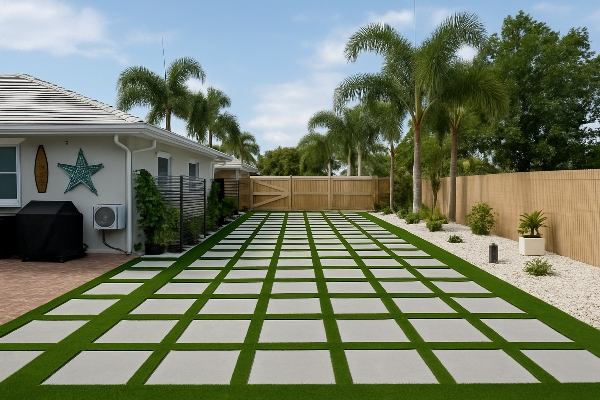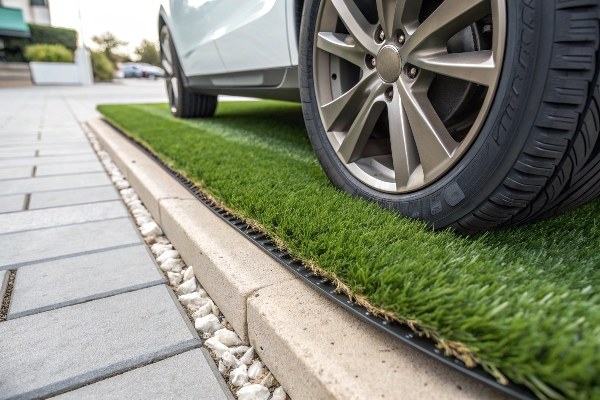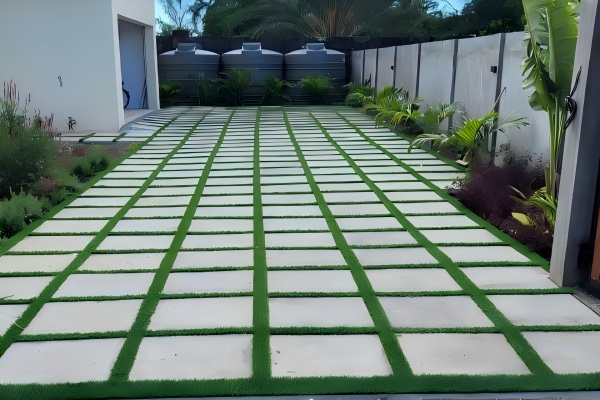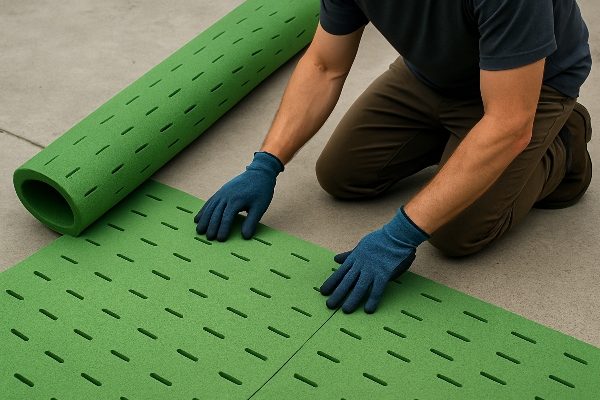Are you tired of your plain concrete driveway? You want a green, lush entrance to your home but know that maintaining real grass under a car is impossible. So, you wonder if artificial grass is the perfect solution.
No, you should not use artificial grass for a full driveway. The weight and constant friction from vehicle tires are too much for the turf. This leads to the grass fibers being pulled out and the backing getting damaged, which shortens its life. However, you can use it in specific designs.

It might be disappointing to hear that a full turf driveway isn’t a good idea. But as an engineer in this industry for many years, I want you to make smart choices for your projects. Understanding why it’s not recommended will help you find a better solution. Let’s look at the details and explore a popular design that gives you the best of both worlds.
Can I drive on artificial grass?
You have this beautiful green lawn, and just for a moment, you think about driving your car over it. It seems convenient, but you worry about leaving ugly marks. So, is it safe to drive on artificial grass?
I do not recommend driving on artificial grass. A high-quality turf might handle a very slow-moving car once or twice. But regular driving creates intense pressure and friction. This will damage the grass fibers and the backing material over time, ruining your investment.

Let’s dive deeper into the technical side. From my experience in the workshop, I can tell you that artificial grass is strong, but it has its limits. We measure the strength it takes to pull a single tuft of grass out of the backing, which we call "tuft bind1." For good quality turf, this is usually between 30 to 70 Newtons of force. However, the friction from a turning car tire can create forces of 2,000 to 3,000 Newtons. That’s a huge difference. This force doesn’t just pull the grass fibers out; it also crushes and wears them down. Over time, this creates flat, matted, and bald spots. The maintenance guides for all quality turf products, including ours, clearly state to avoid placing heavy objects like vehicles on the lawn for extended periods. It’s simply not what the product is designed for.
| Force Type | Typical Force (Newtons) | Result on Turf |
|---|---|---|
| Tuft Bind Strength | 30 – 70 N | Resists light pulling |
| Car Tire Friction | 2,000 – 3,000 N | Pulls out fibers, damages backing |
Can You Build a Driveway with Alternating Artificial Turf and Pavers or Concrete Slabs?
You want a green driveway, but you know a full turf one won’t survive. It’s a common problem for property owners. How can you get that beautiful look without sacrificing strength? There is a very effective solution.
Yes, absolutely. A driveway that alternates between strips of artificial turf and hard pavers or concrete slabs2 is a fantastic solution. This design is very popular because it looks modern and stylish. It gives you the green look you want, while the hard pavers provide the strength needed for cars.

This hybrid design works so well because it channels the forces correctly. The pavers take the full weight and friction of the car tires, which is what they are made for. The artificial grass strips in between are only walked on, which they can handle easily. I’ve helped many clients implement this design, and the results are always impressive. You get the durability of a traditional driveway with the soft, green aesthetic of a lawn. This approach also breaks up the visual monotony of a large paved area, adding significant curb appeal. Another benefit is improved drainage. With the proper sub-base, water can drain away through the turf strips more effectively than on a solid concrete surface. To make this work, a solid, compacted base is needed under both the pavers and the turf to prevent anything from sinking.
Do you need to put anything under artificial grass on concrete?
You have an old concrete patio or walkway and want to cover it with artificial grass. It seems like you could just glue it right on top. But this can lead to problems later. What’s the right way to do it?
Yes, you should always put a layer of something under artificial grass when installing it over concrete. A shock pad or a special drainage underlay is best. This makes the surface softer to walk on and creates channels for water to drain away, preventing mold and puddles.

I have seen people try to install turf directly onto concrete, and it often ends badly. The first problem is drainage. Concrete is non-porous. If the turf is glued directly to it, rainwater gets trapped between the turf’s backing and the concrete. This creates a breeding ground for mold and mildew. The second issue is comfort and appearance. Without a cushion, the turf feels as hard as the concrete underneath. Plus, any small cracks or bumps in the concrete will eventually show through the turf as it settles. The solution is an underlayment. A foam shock pad is the most common choice. It provides softness and has channels to let water flow to the edges. For areas with heavy rain, a dedicated drainage membrane might be better. The proper installation is key: clean the concrete, ensure it has a slight slope for runoff, lay down your underlayment, and then install the turf on top, making sure the edges are well secured.
Conclusion
To sum up, a full artificial grass driveway is not a durable option. However, combining turf with pavers gives you a strong and beautiful result. And for any installation on concrete, an underlayment is essential for drainage and longevity.
_画板-1.png)
_画板-1.png)